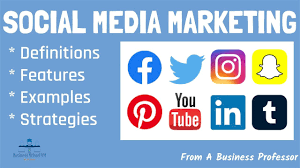The Ultimate Guide to Social Media Advertising: Tips for Maximizing ROI
In today’s fast-paced digital world, social media advertising has become a cornerstone of any successful marketing strategy. With billions of active users on platforms like Facebook, Instagram, Twitter, and LinkedIn, businesses have an incredible opportunity to connect with their target audience. However, running ads without a well-thought-out strategy can lead to wasted budget and low returns.
In this ultimate guide, we’ll cover the essential tips for maximizing your ROI (Return on Investment) with social media advertising, helping you make the most out of every advertising dollar.
1. Set Clear Goals and KPIs
Before you start running ads, it’s crucial to define clear goals and Key Performance Indicators (KPIs) for your campaigns. Whether you want to increase brand awareness, drive website traffic, generate leads, or boost sales, your goals will shape your entire advertising strategy.
Some common goals for social media ads include:
- Brand Awareness: Reach as many people as possible to introduce your brand.
- Lead Generation: Collect contact information from interested customers.
- Website Traffic: Drive visitors to your website or landing pages.
- Conversions/Sales: Focus on driving direct purchases or sign-ups.
By setting specific, measurable goals and aligning your KPIs (like click-through rate, conversion rate, or cost per lead), you can track your ad performance and optimize your campaigns accordingly.
2. Target the Right Audience
One of the biggest advantages of social media advertising is the ability to precisely target your audience based on demographics, interests, behaviors, and more. Proper audience targeting ensures that your ads are shown to the people who are most likely to engage with your content and take action.
Here are a few targeting options to consider:
- Demographics: Age, gender, location, income, education, etc.
- Interests: Based on users’ activity, hobbies, or pages they follow.
- Behavior: Purchase behavior, device usage, or previous interactions with your brand.
- Lookalike Audiences: People similar to your existing customers or website visitors.
Refining your target audience reduces wasted ad spend and increases your chances of reaching people who are most likely to convert.

3. Choose the Right Ad Format for Your Goal
Different ad formats work best for different objectives. Understanding the ad format that aligns with your goal can significantly impact the performance of your campaign. Here are some common social media ad formats to consider:
- Image Ads: Great for simple, straightforward promotions or showcasing products.
- Video Ads: Perfect for storytelling, demonstrations, and increasing brand awareness.
- Carousel Ads: Allow you to showcase multiple products or features in a single ad, ideal for driving traffic to different parts of your website.
- Stories Ads: Short-lived but effective in driving immediate action, especially for limited-time offers or promotions.
- Lead Ads: Specifically designed for lead generation, allowing users to fill out forms directly within the platform.
- Sponsored Posts: Native ads that blend seamlessly with organic content, especially useful for influencer collaborations.
Ensure that the ad format you choose supports your objective and provides a compelling user experience to increase engagement.

4. Craft Compelling Ad Copy and Visuals
The quality of your ad copy and visuals plays a pivotal role in driving conversions. Your messaging should be clear, concise, and tailored to your target audience. Highlight the benefits of your product or service and include a strong call-to-action (CTA) that motivates users to take the desired action.
Here are some tips for crafting effective ad copy:
- Use a compelling headline: Make it attention-grabbing and relevant to the user’s needs.
- Focus on the value proposition: Clearly explain how your product or service solves a problem or benefits the user.
- Create urgency: Use language like “Limited time offer” or “Act now” to prompt users to act quickly.
- Include a strong CTA: Encourage users to take the next step, such as “Shop Now,” “Learn More,” or “Sign Up Today.”
In addition to great copy, high-quality visuals (images or videos) are essential. Use clear, high-resolution images that align with your brand’s aesthetic and evoke emotion. Avoid cluttered visuals and make sure the main focus of the ad is easy to understand.
5. A/B Test Your Ads for Optimal Performance
Running A/B tests (split tests) allows you to compare different versions of your ads to determine which performs best. Test variables such as:
- Ad copy: Try different headlines, CTAs, or messaging.
- Images or videos: Experiment with different visuals to see what resonates most with your audience.
- Target audience: Test various audience segments to find the most responsive group.
- Ad placement: Test ads on different platforms or placements, like Facebook News Feed vs. Instagram Stories.
By continuously testing and optimizing your ads, you can improve performance and ensure that your campaigns deliver the best possible ROI.
6. Set a Realistic Budget and Monitor Performance
Setting a realistic budget is key to managing your ad spend and ensuring that your campaigns are profitable. While social media ads can be affordable, the amount you spend should align with your goals and expected results.
Tips for budgeting:
- Start with a small budget: Test campaigns with a small budget to see what works before scaling up.
- Monitor performance regularly: Keep track of your ad spend and performance to avoid overspending. If an ad isn’t performing well, adjust your targeting, creative, or bid strategy.
- Optimize for cost-efficiency: Focus on reducing your cost per click (CPC) or cost per conversion (CPA) by improving your targeting and ad creative.
By closely monitoring your budget and performance, you can adjust your strategy in real time to maximize ROI.
7. Retarget Your Audience
Retargeting (or remarketing) is a powerful tactic that allows you to show ads to people who have already interacted with your brand. Whether they’ve visited your website, added items to their cart, or engaged with your social media content, retargeting brings them back to your sales funnel.
Some effective retargeting strategies include:
- Abandoned cart ads: Show ads to users who abandoned their cart without completing the purchase.
- Website visitor retargeting: Serve ads to users who visited specific pages on your website but didn’t convert.
- Lookalike audiences: Create lookalike audiences based on previous converters to find new users likely to be interested in your product.
Retargeting increases conversion rates by reaching people who have already shown interest, helping you nurture those leads to the point of purchase.

8. Analyze and Adjust Campaigns Based on Data
Finally, measuring your ad performance and making data-driven adjustments is essential to maximizing ROI. Most social platforms provide detailed analytics for each campaign, including metrics like:
- Impressions
- Click-through rate (CTR)
- Cost per click (CPC)
- Conversion rate
- Return on ad spend (ROAS)
Use this data to identify trends and areas for improvement. If an ad isn’t performing well, analyze the results and adjust accordingly. For example, you may need to refine your targeting, update your ad copy, or adjust your bidding strategy to improve results.
Final Thoughts
Social media advertising is one of the most effective ways to reach your target audience and drive results, but it requires careful planning and ongoing optimization. By following the tips in this guide — setting clear goals, targeting the right audience, testing different strategies, and monitoring your campaigns — you can maximize your ROI and make the most of your advertising budget.
Remember, social media advertising is an ongoing process. Continuously analyze performance, refine your strategy, and adapt to changes in the digital landscape to ensure long-term success.
Related Tags:
- Social Media Advertising
- Facebook Ads
- Instagram Ads
- Social Media Campaigns
- A/B Testing
- ROI Optimization
- Paid Social Media
- Retargeting Ads
- Digital Marketing
- Ad Budgeting
- Conversion Optimization
- Lead Generation Ads













